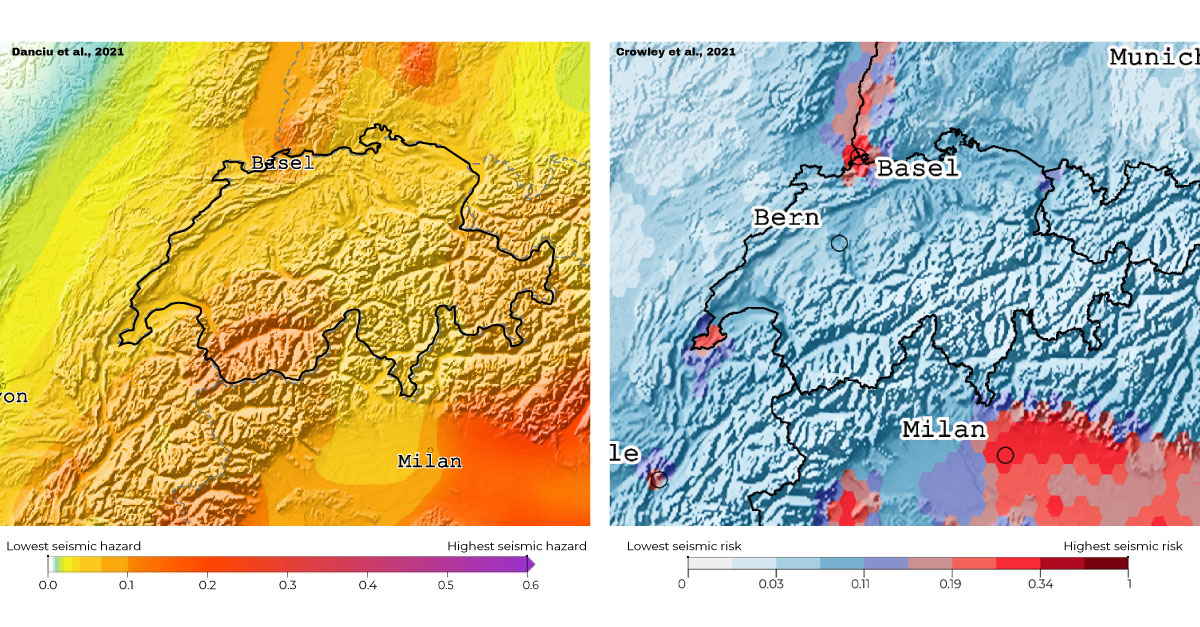2022-04-28
What does the publication of European seismic hazard and risk models mean for Switzerland?
Spring 2022 saw the release of an updated seismic hazard model and the first open-access seismic risk model for Europe. The models describe where, how often and how severely ground shakings triggered by earthquakes are expected to occur as well as their possible impacts on buildings and their occupants (see press release). In contrast to national models, the European models are harmonised across national borders. As such, they are particularly useful in supporting transnational assessments and associated efforts to mitigate the potential effects of earthquakes.
Read more...National construction standards unlikely to change
One important aspect of earthquake mitigation that relies on hazard models is the development of construction standards for earthquake-resistant structures. In Switzerland, this task is the responsibility of the Swiss Society of Engineers and Architects (SIA), which takes as its basis the national hazard assessment prepared by the Swiss Seismological Service at ETH Zurich, last updated in 2015. This is standard practice in countries and regions for which comprehensive hazard assessments are available. The reason for this is that national models depict local conditions with greater precision and in a higher resolution than European models. Nevertheless, the relevant SIA committee will study the new European model closely and analyse possible differences vis-à-vis the national model. However, this is not expected to result in any changes to the currently applicable SIA standards for earthquake-resistant construction (SIA 261 Actions on Structures).
Work under way on national seismic risk model
In contrast to seismic hazard, Switzerland does not yet have a national model for seismic risk. The SED is currently developing such a model in collaboration with the Federal Office for the Environment and the Federal Office for Civil Protection. Due to be published next year, it will show in great detail the damage that can be expected to occur in Switzerland as a result of earthquakes. As with the seismic hazard model, the national seismic risk model will reflect the specific characteristics of Switzerland more accurately than the European model and will therefore serve as the primary reference for Switzerland-wide risk analyses. However, the European model is helpful when it comes to making risk comparisons between countries. It also offers a valuable basis for comparison for the national model.
European results confirm national hazard analysis and provide initial indications of high-risk regions
Initial analyses by the SED suggest that the European seismic hazard assessment differs only minimally from the national assessment. There is currently no reference for seismic risk, but in the European model Basel and Geneva stand out as places at particularly high risk in Switzerland. This is hardly surprising in the case of Basel, as all relevant seismic risk factors come together there: a high density of residents and property, a high seismic hazard and many vulnerable buildings. Compared with Basel, Geneva has a lower seismic hazard. However, a fault zone in the French Alps plays a key role in the European risk model as a possible source of more distant but potentially large earthquakes. As with Basel, there is also a high density of residents and property and a vulnerable building stock, much of which is built on soft subsoil that is not good for earthquakes (sedimentary basin). Furthermore, on the map in the European model, the core zone in Geneva lies in a single cell, whereas in Zurich, which has similar conditions, it is spread across three cells. From a purely visual point of view, therefore, the risk appears greater for Geneva than for Zurich, for example.
The fact that other urban or particularly vulnerable Swiss areas do not show up more strongly in the European seismic risk model is mainly due to two factors. Firstly, Swiss cities tend to be small by European standards and are therefore at less risk than other large urban areas. Secondly, the results are normalised with gross domestic product (GDP). In other words, the risk assessment takes into account a country's ability to mitigate the effects of an earthquake. In 2021, Switzerland had the second highest GDP of all European countries after Luxembourg. The Swiss model will present the seismic risk landscape here in a more nuanced way, not only because it is not subject to such a weighting but also because it incorporates additional datasets, such as more detailed ground reinforcement maps as well as building vulnerability models developed specifically for Switzerland.
